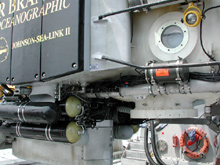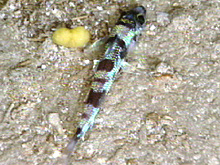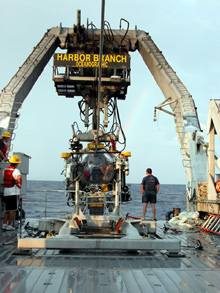
The stern section of the Johnson-Sea-Link II submersible, where Allen Brooks sat for his first dive. Note the porthole at top right. Click image for larger view.
To the Abyss and Back
August 17, 2003
Allen Brooks, PhD
Benthic Ecologist
U.S. Geological Survey
Today, our first full day at sea, some might say that all the stars and planets aligned for us -- the seas were calm and the forecast was for continuing good weather. Hence, we were able to deploy the Johnson-Sea-Link (JSL) II submersible this morning and this afternoon, as planned.
Our efforts concentrated on the middle-slope coral banks (made up, for the most part, of the branching coral Lophelia pertusa) in depths of 400-700 m on the Blake Plateau. First discovered on the Blake Plateau during the late 1950s, many Lophelia coral locations were suggested by the U.S. Geological Survey's (USGS) sidescan sonar mapping of the continental slope. Yet no explicit data exists to confirm these suggestions. We were going down in the sub to see if we could get the explicit data.
In addition to scouting out these "suggested" Lophelia reefs, the two members of our science team went out this morning to field test a new digital camera/computer system mounted on the top of the JSL's collection basket at the forward middle of the sub. Digital photography, as opposed to video, records will enable us to record more clear imagery of that which we encounter on our dives; scientists will be better equipped to locate and speciate the organisms captured by the camera's lens.
This afternoon, I was scheduled for my very first submersible dive. Martha Nizinski, our invertebrate expert, would be there, too.
Working with the USGS for the past year and a half, I have been on several cruises where we used a remotely operated vehicle (ROV) to explore hard-bottom areas in the Gulf of Mexico. With an ROV, you have a view of the bottom in “real time” and can request that the ROV operator pan the camera in one direction or another to get closer to items of interest. When using an ROV, however, you are still "detached" from the bottom, and you do not get a good picture of the true size of the things you are observing.
Using the JSL II, a four-person submersible (two scientific crew, two pilots), we dove off of the coast of North Carolina onto an area that looked like it had “structure” based upon the ship’s depth recorder. I shared my spot with the JSL II co-pilot in the stern section of the submersible, which has two portholes through which to observe the bottom. There was also a small video screen that I could use to view what the scientist and pilot in the front bubble of the sub were observing as well.

Greeneyes are known for their iridescent blue-green mottling and enormous eyes. Photo courtesy of Leslie Sautter. Click image for larger view.
It is very exciting to realize that you are the first people to ever see this part of the sea bottom. My expectations were quite different from what I observed. I knew we were going fairly deep (around 2,000 ft), where it is completely pitch black, so I expected to find a swarm of fish attracted to the submersible lights. In actuality, we saw very few fish -- only a few greeneyes and one angler fish. The fish were fairly spread out, with no two fish within a meter or so of each other. The bottom was sparsely covered with black corals, sea pens, soft corals, and small colonies of Lophelia. These hard-bottom invertebrates were fairly short in stature (6-8 in tall) but provided a substantial amount of three-dimensional structure relative to what would otherwise be flat bottom. We observed a few crabs nestled at the base of some Lophelia colonies, but I was surprised to see very few mobile species using the corals for protective habitat.

Living structures, such as this soft coral which was found at a depth of more than 1400 feet, provide important habitat for fish and other marine life. Click image for larger view.
The topography of the dive was incredible. We wound up diving down to 2,100 ft at the bottom of what appeared to be a trough. As we came up the side of the trough onto the top plateau, the seascape had subtle changes, transitioning from dominant Lophelia colonies to areas with fewer hard corals and relatively more gorgonians. As they say, “A picture is worth a thousand words." The opportunity to dive down and see this area of the deep sea with my own eyes is worth a million. Having been there, I have a better perspective from which to analyze any video I see of deep-water coral habitats.

As the JSL is recovered, a very faint rainbow can be seen arching to the right of the sub between it and the A-frame. Click image for larger view.
As a side note, one other experience I will always remember is watching out the porthole window and observing the bioluminescent organisms during our descent. These animals are known to suddenly produce light when a predator threatens, perhaps to discourage an attack. Most likely what I saw were light-producing dinoflagellates (the light being produced by their cells changing shape as they encountered the sub). The bioluminescent organisms looked to me like shooting stars in a pitch-black sky, or a string of white Christmas lights pulsating through the water column. To read more about bioluminescence, refer to the essay Visual Ecology and Bioluminescence from the 2002 "Islands in the Stream: Exploring Underwater Oases" expedition.





















